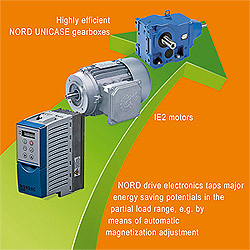
Posted to News on 25th Oct 2011, 11:11
Combined motor/drive technologies cut energy consumption
It is estimated that more than two-thirds of the total energy spend for industrial automation is consumed by electric drive technology and that an individual electric motor's energy consumption makes up about 98 per cent of its total cost of ownership over its average life. From these factors it is clear that investment in efficient drive technology is essential. The IEC 60034-30 standard and the mandatory requirement in Europe for IE2 energy efficiency class motors in many applications from June 2011 will begin to ensure reduced energy consumption on a global scale. Further statutory initiatives for IE3 Premium Efficiency motors will come into force in the next few years and Nord Drivesystems has already assembled a complete range of IE2 and IE3 motors that bring benefits of increased efficiency, less waste, reduced greenhouse gases, increased service life and reduced operating costs.

However, it is Nord Drivesystems' view that energy saving does not stop at optimising the consumption of individual motors but that practical efficiency measures and a 'green' approach should also be built into the complete drive system, together with consideration for the overall application process. With many years' experience in energy-saving motors and drive technologies, Nord has developed innovative efficiency-optimised drive features that include high-frequency operation, automatic flux adjustment, energy recovery, and intermediate circuit coupling.
Higher operating frequency
An example of this is the option of operating asynchronous motors with an output frequency which is higher than that of the mains in order to increase efficiency. Motors with 230V/400V star-delta circuitry can be operated at up to 87Hz with a 400V inverter in a delta connection, so the motor operates at a higher speed of up to 87Hz with the rated torque. Up to approximately 100Hz, this increase in frequency results in an improvement in the efficiency of the motor by up to 5 per cent.
'Intelligent control' is another way to save energy. For asynchronous motors, frequency inverters generally maintain the magnetic flux level required for yielding the full torque over the whole speed range, resulting in unnecessary losses during partial-load operation. Nord's SK 200E, SK 500E, and SK 700E- frequency inverters can save resources by automatically reducing magnetisation when the motor is operated under partial load conditions for potential energy savings of up to 30 per cent.
While conventional frequency inverter applications discharge the braking energy as heat, more efficient and eco-friendly drives reuse this excess energy via intermediate circuits and regenerative braking, reducing mains power consumption. The efficiency of a system can be increased even further; when all the drives are linked to form a DC network, the generated energy is supplied directly to other drive units. The energy not used by the network may also be fed back to the mains via a regeneration unit.
Follow the link for more information about Nord's energy-efficient motors and drives.






























